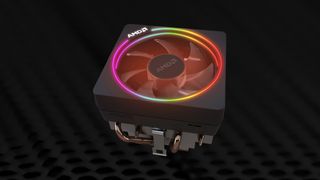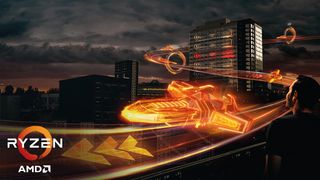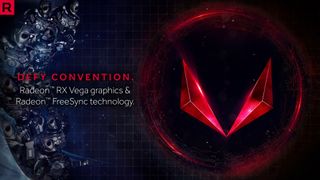
This article is sponsored by AMD.
We love PC gaming (hint, it’s in our name), and we love the hardware that drive it. Our pursuit for high performance is a restless one, driven by our addiction for the newer, faster, better. AMD’s ecosystem continues to impress us with its exceptional quality and performance, and we want to tell you how exactly it achieves this.
AMD 2nd Gen Ryzen Processors
The AMD 2nd Gen Ryzen processors bring elite performance to all calibers of gamers. Whether you’re looking to purchase a pre-built rig, or itching to build one yourself, they should be at top of your must-have list.
Gaming has evolved to encompass an important social aspect. In addition to having fun, gamers are recording, streaming, talking with friends, and sharing. The 2nd Gen Ryzen processors have the multitasking capabilities to keep up with any busy gamer. Between the efficient 4-core Ryzen 3 2200G to the beastly 8-core Ryzen 7 2700X, there is always a perfect processor that can tackle your gaming needs.
Built using the advanced 12nm transistors, the 2nd Gen Ryzen processors run faster, cooler, and more efficient than ever before. Its new “Zen+” microarchitecture reduces cache latency and memory latency, improving the IPC (Instructions per Clock) by 3 percent. We know you’re already forcing air out of your nose. “3 percent, that’s it?” you may scoff. But don’t wave your hand just yet; when combined with the XFR 2 and Precision Boost 2, the effect of a “measly” 3 percent is multiplied.
XFR 2 (Extended Frequency Range 2) continuously pushes the clock speed closer to the processor’s max boost clock as long as the temperature stays under a thermal threshold. With 2nd gen Ryzen, AMD has reworked XFR to take advantage of its higher power and thermal ceiling thanks to the more efficient transistors and microarchitecture. Not only does this ensure that the CPU runs at the highest speeds possible under load, it also means that a good cooler can actually make a difference in performance, not just reduce noise.
Precision Boost 2, on the other hand, intelligently detects which cores are working and individually boost their clock speeds. For example, if you’re running a heavy single threaded application, then Precision Boost 2 pushes that core to its max clock without touching the rest of the cores. For when all cores are activated, Precision Boost 2 works in conjunction with XFR 2 to push all cores to their fastest possible clock without exceeding the thermal limit.
But what about the overclocking enthusiasts who wants to fine-tune their chips at their discretion? No problem. All 2nd Gen Ryzen processors – that’s right, all of them – are user overclockable. Feel free to share how far you were able to push your chip with AMD’s vibrant community.
You live, you learn. The age-old platitude applies to the 2nd Gen Ryzen processors as well. Their integrated neural net predicts the next steps in your workflow based on usage and finds the most efficient pathways before the commands are even issued. It improves the efficiency of handling data, reduces the latency between issuing commands and their execution, and ultimately saving you precious time. Talk about working hard and smart.
Got a low-capacity SSD? Then AMD StoreMI can help you get the most out of it. It automatically moves over the most frequently used files onto the SSD. StoreMI can drastically improve your game’s load time, system startup speed, and consolidate your file libraries for faster access. All you need is an AMD 400 series motherboard and the system will do the rest.

AMD Radeon RX Graphics
The graphics card is the soul of any gaming rig. Its performance directly dictates the quality of your gaming experience. For gamers looking to play today’s most demanding titles at their maximum detail settings, AMD’s Radeon RX graphics is the way to go.
AMD’s current graphics family is divided into two lineups: the performance Radeon RX 500 series and the enthusiast Radeon RX Vega series.
The AMD Radeon RX 500 series boasts a slew of design enhancements over the previous generation. Its Polaris microarchitecture is built using high-performance 14nm transistors, with special optimizations paid to run the latest graphics APIs such as DirectX 12 and Vulkan. The refined architecture allows the GPU to run at higher clock speeds and offer an even more galvanizing gaming experience.
Whereas the Radeon RX 500 series embodies the pinnacle of efficiency and performance, the AMD Radeon RX Vega series focuses on providing the ultimate gaming immersion. At its heart are GCN 5.0 (Graphics Core Next) graphics cores and a dazzling array of bleeding-edge technology. Performance features such as High-Bandwidth Cache, HBM2 memory, new programmable geometry pipelines, and a new pixel engine, work in synergy to drive the highest frame rate in today’s most demanding titles. Check out our deep dive for a complete guide on all of Vega’s best features.
AMD is committed to delivering only the best to the gamers. In addition to tireless revising its chip designs, it also works closely with the AIB (add-in board) partners to ensure a consistent level of quality and performance. Each card is rigorously tested so gamers can focus on enjoying rich, immersive visuals without hassle.
The amazing hardware is flanked with the exceptional AMD Radeon Software. Among its robust repertoire of performance, recording, and social features, Radeon Chill and WattMan deserve a special mention.
Radeon Chill greatly reduces the GPU’s power consumption without affecting performance. It achieves this by dynamically adjusting the frame time – not frame rate – based on the gamer’s movements. When the gamer is standing still and no action is occurring on-screen, Radeon Chill increases the frame time to simulate a lower frame rate. As soon as movement is detected, the frame time is lowered for best performance. In one test scenario using World of Warcraft, Radeon Chill was able to reduce power consumption by 31 percent and decrease the average GPU temperature by 11 degrees. Less power consumption means less heat, noise, and wasted energy.
Enthusiasts who like to tinker with their chips will undoubtedly appreciate the Radeon WattMan, the one-stop panel that gives gamers complete control over their GPU’s performance. Gamers can easily adjust power, engine clock, memory clock, and fan speed. When you think you have found the best performance profile for your GPU, you can easily export your settings and share them with the community.
All of these features, along with AMD’s excellent ReLive recording, Radeon Overlay, stream integration, and Enhanced Sync are completely free with AMD graphics cards. Even as we speak, AMD is working on bringing you even more features. Keep your eyes peeled for the next big Radeon Software update.

Tear-Free Monitors
Performance is only one half the equation. The other half is the thing your stare at all the time – the monitor. A good monitor is essential in accurately converting the performance of you rig into images you can appreciate. AMD Radeon FreeSync-certified monitors can help you game better by eliminating screen tearing.
Screen tearing is a leading detriment to gaming immersion. They’re artifacts that occur when more than one frame is displayed on the screen at the same time. Eliminating screen tearing enhances the gameplay’s smoothness and allows gamers to execute more accurate mouse movements.
The most prevalent solution for this was VSync. Short for Vertical Synchronization, VSync attempts to sync up the in-game frame rate with the monitor’s refresh rate. It works by holding onto a pre-existing frame until either the next frame is fully rendered or the monitor is able to fully refresh to the next one.
In recent years, VSync has grown to be an inadequate solution due to its bevy of problems. First and foremost is the increased input lag. Because the frames are held on to for longer than they should, players often notice significant delays between the time of input and the time it’s reflected on screen. In addition, if the frame rate dips below the monitor’s refresh rate, it will default to a much lower performance limit, severely crippling your graphics card’s performance despite its actual potential. Needless to say, a better remedy is required.
Enter AMD Radeon FreeSync. AMD’s FreeSync technology eliminates screen tearing without any of the drawbacks of traditional VSync. It dynamically limits the output frame rate of the graphics card to match that of the monitor with no performance impact. This means that you’ll remain screen tearing free at all frame rates. And because it utilizes Adaptive Sync, a display sync standard developed by VESA, the solution is also simpler and inexpensive to implement. The bar of entry is low, too. All you need is a FreeSync-certified monitor and a compatible Radeon graphics card.
The AMD Radeon FreeSync 2 HDR brings deep enhancement for HDR (high-dynamic range) rendering. By offloading tone-mapping to the FreeSync 2 Transport, latency is greatly reduced on FreeSync 2 HDR compatible monitors. In order to obtain a FreeSync 2 HDR certificate, a monitor must meet AMD’s rigorous color and brightness standards. So not only are you getting stutter-free gaming, you’re also getting the best image quality.
You won’t have to dig deep to find good FreeSync monitors at various price points. AMD has partnered with over 20 display manufacturers to produce high-quality FreeSync displays. Make sure to pick one up with your AMD graphics card.
Sponsored by AMD
PC Gamer Newsletter
Sign up to get the best content of the week, and great gaming deals, as picked by the editors.
